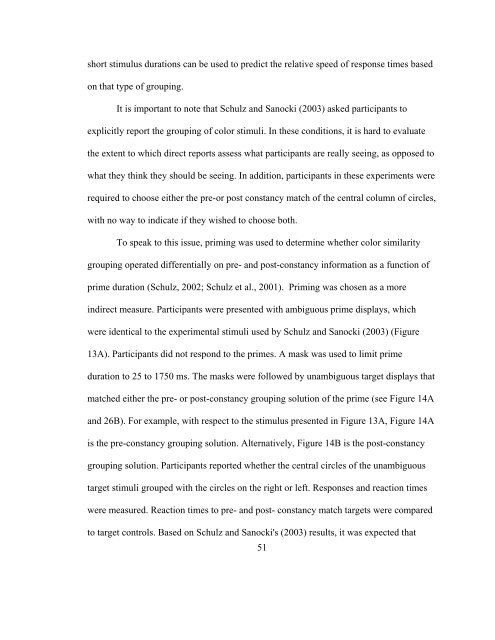The Use of Iambic Pentameter in the
The Use of Iambic Pentameter in the
The Use of Iambic Pentameter in the
You also want an ePaper? Increase the reach of your titles
YUMPU automatically turns print PDFs into web optimized ePapers that Google loves.
short stimulus durations can be used to predict <strong>the</strong> relative speed <strong>of</strong> response times based<br />
on that type <strong>of</strong> group<strong>in</strong>g.<br />
It is important to note that Schulz and Sanocki (2003) asked participants to<br />
explicitly report <strong>the</strong> group<strong>in</strong>g <strong>of</strong> color stimuli. In <strong>the</strong>se conditions, it is hard to evaluate<br />
<strong>the</strong> extent to which direct reports assess what participants are really see<strong>in</strong>g, as opposed to<br />
what <strong>the</strong>y th<strong>in</strong>k <strong>the</strong>y should be see<strong>in</strong>g. In addition, participants <strong>in</strong> <strong>the</strong>se experiments were<br />
required to choose ei<strong>the</strong>r <strong>the</strong> pre-or post constancy match <strong>of</strong> <strong>the</strong> central column <strong>of</strong> circles,<br />
with no way to <strong>in</strong>dicate if <strong>the</strong>y wished to choose both.<br />
To speak to this issue, prim<strong>in</strong>g was used to determ<strong>in</strong>e whe<strong>the</strong>r color similarity<br />
group<strong>in</strong>g operated differentially on pre- and post-constancy <strong>in</strong>formation as a function <strong>of</strong><br />
prime duration (Schulz, 2002; Schulz et al., 2001). Prim<strong>in</strong>g was chosen as a more<br />
<strong>in</strong>direct measure. Participants were presented with ambiguous prime displays, which<br />
were identical to <strong>the</strong> experimental stimuli used by Schulz and Sanocki (2003) (Figure<br />
13A). Participants did not respond to <strong>the</strong> primes. A mask was used to limit prime<br />
duration to 25 to 1750 ms. <strong>The</strong> masks were followed by unambiguous target displays that<br />
matched ei<strong>the</strong>r <strong>the</strong> pre- or post-constancy group<strong>in</strong>g solution <strong>of</strong> <strong>the</strong> prime (see Figure 14A<br />
and 26B). For example, with respect to <strong>the</strong> stimulus presented <strong>in</strong> Figure 13A, Figure 14A<br />
is <strong>the</strong> pre-constancy group<strong>in</strong>g solution. Alternatively, Figure 14B is <strong>the</strong> post-constancy<br />
group<strong>in</strong>g solution. Participants reported whe<strong>the</strong>r <strong>the</strong> central circles <strong>of</strong> <strong>the</strong> unambiguous<br />
target stimuli grouped with <strong>the</strong> circles on <strong>the</strong> right or left. Responses and reaction times<br />
were measured. Reaction times to pre- and post- constancy match targets were compared<br />
to target controls. Based on Schulz and Sanocki's (2003) results, it was expected that<br />
51

















